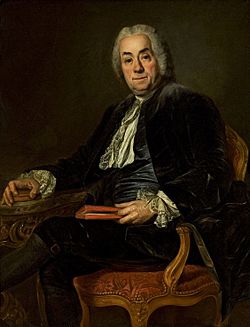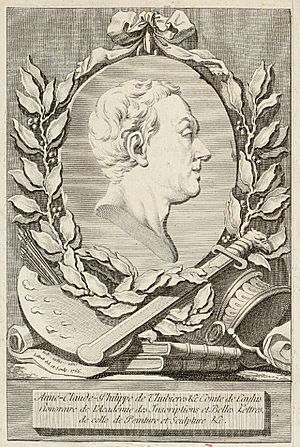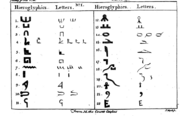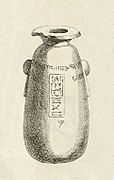Anne Claude de Caylus facts for kids
Quick facts for kids
Anne Claude de Caylus
|
|
|---|---|

Count de Caylus by Alexander Roslin, National Museum, Warsaw
|
|
| Born | 31 October 1692 |
| Died | 5 September 1765 (aged 72) |
| Nationality | French |
| Scientific career | |
| Fields | antiquarian archaeologist |
Anne Claude de Tubières-Grimoard de Pestels de Lévis, comte de Caylus, marquis d'Esternay, baron de Bransac (born October 31, 1692 – died September 5, 1765), was a French nobleman. He was very interested in ancient objects and art. People sometimes call him a "proto-archaeologist" because he studied old things before archaeology became a proper science.
He was born in Paris, France. His father was a general, and his mother, Marthe-Marguerite, was a writer. She wrote interesting memories about the court of King Louis XIV. Anne Claude de Caylus also had a younger brother, Charles, who became a naval officer.
Contents
Exploring the Ancient World
As a young man, Caylus served in the French army. After the war ended in 1714, he began to travel a lot. He visited places like Italy, Greece, and parts of the Middle East. He also went to England and Germany.
During his travels, he spent much time studying and collecting ancient items. He became a member of important French academies. These groups focused on art and old writings.
Collecting Ancient Treasures
One of his most famous works was a large book series. It was called Recueil d'antiquités égyptiennes, étrusques, grecques, romaines et gauloises. This means "Collection of Egyptian, Etruscan, Greek, Roman, and Gallic Antiquities." It had many pictures and was very useful for artists. They used it to get ideas for new art in the Neoclassical style.
He also wrote about ancient Roman gold coins. His focus on the actual objects helped people learn more about history. He even tried to rediscover an ancient painting method called encaustic painting. This method used wax as a medium.
Art and Etchings
Caylus was also a talented artist himself. He made many etchings, which are a type of print. He often copied drawings by famous Italian and French artists. He also made etchings from drawings by his friends, like the artist Antoine Watteau.
He paid for engravings to be made from copies of ancient paintings. He also wrote books to inspire artists. These books described scenes from famous old stories like the Iliad and the Odyssey.
His interest in old things was not just about Greece and Rome. He also studied ancient French monuments. For example, he had drawings made of the large stone structures called megaliths in Aurille.
Helping New Artists
Caylus liked to support artists who were just starting out. He helped a young art collector named Pierre-Jean Mariette. However, some people thought he could be a bit difficult to please. The writer Denis Diderot once joked that Caylus was "the cruellest of connoisseurs."
Caylus also had a fun side. He wrote many witty stories about life in Paris. He also wrote several fairy tales. These stories mixed traditional French fairy tales with ideas from Eastern stories. They were published in collections like Les Féeries nouvelles and Les Contes orientaux.
Items from Caylus' Collection
-
Illustration from the 1765 edition of The Divine Legation of Moses, showing the theory of the Comte de Caylus on Egyptian hieroglyphics.
-
Sphinx of Pharaoh Apries of the Twenty-sixth Dynasty of Egypt, from the collection of Count Caylus, now at the Louvre.
Fairy Tales by Caylus
The folklorist Andrew Lang included some of Comte de Caylus's tales in his famous color fairy books. These stories are:
- Rosanella (original title: Rosanie)
- Heart of Ice (original title: Le prince Courtebotte et la princesse Zibeline)
- Sylvain and Jocosa (original title: Tourlou et Rirette)
- The Yellow Bird (original title: L'Oiseau Jaune) – this story is part of Sylvain and Jocosa
- Fairy Gifts (original title: Les dons)
Other tales by Caylus were also published by Andrew Lang, but without mentioning Caylus as the author:
- Prince Narcissus and the Princess Potentilla (original title: La Princesse Pimprenella et Le Prince Romarin)
- Prince Featherhead and the Princess Celandine (original title: Le Prince Muguet et la Princesse Zaza)
- Prince Vivien and the Princess Placida (original title: Nonchalante et Papillon)
The British writer James Planché also translated some of de Caylus's tales into English:
- Princess Minute and King Floridor (original title: La princesse Minutie et le roi Floridor)
- The Impossible Enchantment (original title: L'enchantement impossible)
- Bleuette and Coquelicot (original title: Bleuette et Coquelicot)
The tale Mignonette was also translated into English as Prince Chaffinch.
Works
- Recueil d'antiquités égyptiennes, étrusques, grecques, romaines et gauloises : Tome cinquième (1762) (A collection of Egyptian, Etruscan, Greek, Roman, and Gallic antiquities)
See also
 In Spanish: Anne Claude de Caylus para niños
In Spanish: Anne Claude de Caylus para niños






